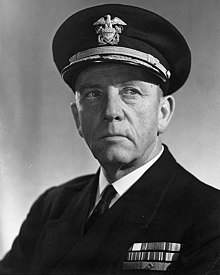Alan Goodrich Kirk (October 30, 1888 – October 15, 1963) was a United States Navy admiral during World War II who most notably served as the senior naval commander during the Normandy landings. After the war he embarked on a diplomatic career serving as US ambassador to Belgium, the Soviet Union and the Republic of China (Taiwan).
Alan Goodrich Kirk | |
|---|---|
 Admiral Alan G. Kirk | |
| United States Ambassador to Taiwan | |
| In office June 7, 1962 – January 18, 1963 | |
| President | John F. Kennedy |
| Preceded by | Everett F. Drumright |
| Succeeded by | Jerauld Wright |
| United States Ambassador to the Soviet Union | |
| In office July 4, 1949 – October 6, 1951 | |
| President | Harry S. Truman |
| Preceded by | Walter Bedell Smith |
| Succeeded by | George F. Kennan |
| United States Ambassador to Belgium | |
| In office April 1, 1946 – May 6, 1949 | |
| President | Harry S. Truman |
| Preceded by | Charles W. Sawyer |
| Succeeded by | Robert Daniel Murphy |
| Personal details | |
| Born | Alan Goodrich Kirk October 30, 1888 Philadelphia, Pennsylvania, U.S. |
| Died | October 15, 1963 (aged 74) Washington, D.C., U.S. |
| Resting place | Arlington National Cemetery |
| Spouse |
Lydia Chapin (m. 1918) |
| Relatives | Caspar F. Goodrich (uncle) |
| Education | United States Naval Academy |
| Military service | |
| Allegiance | United States |
| Branch/service | United States Navy |
| Years of service | 1909–1946 |
| Rank | Admiral |
| Commands | U.S. Naval Forces, France |
| Battles/wars | |
| Awards | |
Biography
editKirk graduated from the United States Naval Academy in the class of 1909. His classmates included Jesse B. Oldendorf, Olaf M. Hustveldt, and Theodore S. Wilkinson.[1] Kirk served in the United States Navy during World War I and World War II. During his wartime naval service, Kirk became the U.S. naval attaché in London (1939 to 1941). He was Director of the Office of Naval Intelligence from March 1941 but, obstructed and opposed by Rear Admiral Richmond Turner, he was unable to develop the office into an effective centre along the lines of the British Royal Naval Operational Intelligence Centre (which he had seen whilst in London). Eventually, he requested a transfer to an Atlantic destroyer squadron.[2]
Kirk served as an amphibious commander in the Mediterranean in 1942 and 1943 (the Allied invasion of Sicily and Italy). In addition, he was the senior U.S. naval commander during the Normandy landings of June 6, 1944, embarked on the heavy cruiser USS Augusta, and as Commander U.S. Naval Forces, France during 1944 and 1945. He retired from the Navy as a full admiral in 1946. He was decorated with Legion of Honour by the Provisional Government of the French Republic for his World War II service.[3]
After retirement from the United States Navy, Kirk embarked on a diplomatic career, and subsequently served in several United States embassies abroad, beginning with the combined posting of U.S. Ambassador to Belgium/U.S. Envoy to Luxembourg (resident in Brussels, Belgium), 1946–49; as U.S. Ambassador to the Soviet Union, July 4, 1949, to October 6, 1951; and finally as United States Ambassador to the Republic of China (Taiwan), June 7, 1962, to January 16, 1963. He served as ambassador to the Soviet Union during the beginning of the Korean War, and expressed concern that the conflict could escalate to World War III, comparing it to proxy conflicts of the 1930s such as the Spanish Civil War and the Soviet–Japanese border conflicts which he believed precipitated World War II.[4]
Admiral Kirk took his post as the second president of American Committee for the Liberation of the Peoples of Russia, in February 1952. As a former U.S. ambassador to the Soviet Union, he oversaw the recruitment of emigres in New York City and Munich, a group that would later form the core of Radio Liberty's staff. Less than a year after taking office, Kirk was forced to resign due to poor health. Also in 1952, he served briefly as Director of the Psychological Strategy Board, which planned for and coordinated government psychological operations.[5]
In 1962 he was portrayed onscreen in the film The Longest Day by Australian actor John Meillon.[6]
Alan Goodrich Kirk died on October 15, 1963 in New York at the age of 74 and was buried at Arlington National Cemetery.[7]
See also
editReferences
edit- ^ Lucky Bag. Nimitz Library U. S. Naval Academy. First Class, United States Naval Academy. 1909.
{{cite book}}: CS1 maint: others (link) - ^ Gannon, Michael (1991). Operation Drumbeat. New York: Harper Collins. pp. 160–161. ISBN 0-06-092088-2.
- ^ "All Hands - The Bureau of Naval Personnel Information Bulletin; June 1945" (PDF). navy.mil. United States Navy Websites. Archived from the original (PDF) on 15 June 2020. Retrieved 11 February 2017.
- ^ Carson, Austin (2018-12-31), "5. The Korean War (1950– 1953)", Secret Wars: Covert Conflict in International Politics, Princeton University Press, p. 150, doi:10.1515/9780691184241-006, ISBN 978-0-691-18424-1, S2CID 239293400, retrieved 2022-02-16
- ^ "Staff Member and Office Files: Psychological Strategy Board Files". Harry S. Truman Presidential Library.
- ^ "Full Cast and Crew: The Longest Day". Internet Movie Database.
- ^ "US Naval Academy Notable Graduates: Alan G. Kirk". United States Naval Academy.
Further reading
edit- Kohnen, David. Alan Goodrich Kirk: U.S. Navy Admiral of Intelligence and Diplomacy. In: John Hattendorf and Bruce Elleman (Eds.). Nineteen Gun Salute: Profiles in U.S. Navy Leadership in Wartime Operations. Newport, Rhode Island: Naval War College Press, 2010, pp. 75–92.
- Kirk, Lydia. Postmarked Moscow.
External links
edit- Media related to Alan Goodrich Kirk at Wikimedia Commons
- Newspaper clippings about Alan Goodrich Kirk in the 20th Century Press Archives of the ZBW